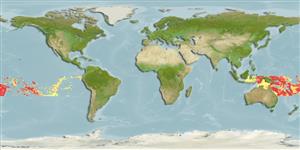Environment: milieu / climate zone / depth range / distribution range
Ecologia
marino; acqua dolce; salmastro demersale; catadromo (Ref. 51243); distribuzione batimetrica 0 - 3000 m (Ref. 86942). Tropical; 1°S - 25°S
Pacific Ocean: Sulawesi, Indonesia to the Society Islands. Also recorded from Pitcairn (Ref. 9828).
Size / Peso / Age
Maturity: Lm ? range ? - ? cm
Max length : 100.0 cm TL maschio/sesso non determinato; (Ref. 9828); 165.0 cm SL (female); peso massimo pubblicato: 0.00 g
Vertebre: 110 - 114. The only species that can be either variegated or plain-colored. Mottled individuals most closely resemble Anguilla celebensis and A. interioris in having broad, undivided tooth bands, but their ranges do not overlap. Plain-colored individuals most closely resemble A. japonica and A. borneensis, but those species both geographically distant. A. obscura is also plain-colored but has a shorter dorsal fin (Ref. 9828). The skin is grey to yellowish and more or less spotted with brown or black. It can be sometimes uniformly brownish red on the flanks and the back. The belly is white. Young specimens are grey and do not have spots (Ref.48622).
Found in rocky pools, often in coastal streams (Ref. 2847). No separate statistics available (Ref. 9828). The maximum weight (9,000 g) refers to the length (165 cm TL) of a female individual (Ref. 48622).
Life cycle and mating behavior
Maturities | Riproduzione | Spawnings | Egg(s) | Fecundities | Larve
Smith, D.G., 1999. Anguillidae. Freshwater eels. p. 1630-1636. In K.E. Carpenter and V.H. Niem (eds.) FAO species identification guide for fishery purposes. The living marine resources of the WCP. Vol. 3. Batoid fishes, chimaeras and bony fishes part 1 (Elopidae to Linophrynidae). FAO, Rome. (Ref. 9828)
IUCN Red List Status (Ref. 130435)
Threat to humans
Harmless
Human uses
Pesca: commerciale
Strumenti
Special reports
Download XML
Fonti Internet
Estimates based on models
Preferred temperature (Ref.
123201): 3.7 - 9.6, mean 4.9 °C (based on 415 cells).
Phylogenetic diversity index (Ref.
82804): PD
50 = 0.5000 [Uniqueness, from 0.5 = low to 2.0 = high].
Bayesian length-weight: a=0.00076 (0.00037 - 0.00155), b=3.17 (3.00 - 3.34), in cm total length, based on LWR estimates for this Genus-body shape (Ref.
93245).
Trophic level (Ref.
69278): 3.8 ±0.7 se; based on size and trophs of closest relatives
Resilienza (Ref.
120179): Molto basso, tempo minimo di raddoppiamento della popolazione più di 14 anni (Preliminary K or Fecundity.).
Fishing Vulnerability (Ref.
59153): Very high vulnerability (90 of 100).
